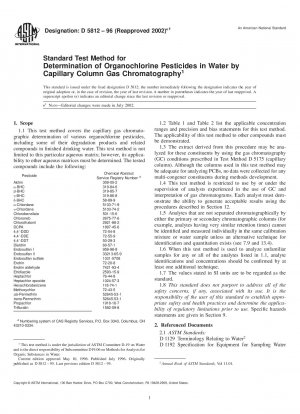ASTM D5812-96(2002)e1
Standard Test Method for Determination of Organochlorine Pesticides in Water by Capillary Column Gas Chromatography
- Standard No.
- ASTM D5812-96(2002)e1
- Release Date
- 1996
- Published By
- American Society for Testing and Materials (ASTM)
- Status
- 2011-01
- Latest
- ASTM D5812-96(2002)e1
- Scope
The extensive and widespread use of organochlorine pesticides and PCBs has resulted in their presence in all parts of the environment. These compounds are persistent and may have adverse effects on the environment. Thus, there is a need to identify and quantitate these compounds in water samples.
1.1 This test method covers the capillary gas chromatographic determination of various organochlorine pesticides, including some of their degradation products and related compounds in finished drinking water. This test method is not limited to this particular aqueous matrix; however, its applicability to other aqueous matrices must be determined. The tested compounds include the following:
Pesticide Chemical Abstract Service Registry Number Aldrin 309-00-2 -BHC 319-84-6 -BHC 319-85-7 -BHC 319-86-8 -BHC 58-89-9 -Chlordane 5103-71-9 -Chlordane 5103-74-2 Chlorobenzilate 501-15-6 Chloroneb 2675-77-6 Chlorothalonil 2921-88-2 DCPA 1897-45-6 4,4`-DDD 72-54-8 4,4`-DDE 72-55-9 4,4`-DDT 50-29-3 Dieldrin 60-57-1 Endosulfan I 959-98-8 Endosulfan II 33213-65-9 Endosulfan sulfate 1031-0708 Endrin 72-20-8 Endrin aldehyde 7421-93-4 Etridiazole 2593-15-9 Heptachlor 76-44-8 Heptachlor epoxide 1024-57-3 Hexachlorobenzene 118-74-1 Methoxychlor 72-43-5 cis -Permethrin52645-53-1 trans -Permethrin52645-53-1 Propachlor 1918-16-7 Trifluralin 1582-09-8 1.2 and list the applicable concentration ranges and precision and bias statements for this test method. The applicability of this test method to other compounds must be demonstrated.
1.3 The extract derived from this procedure may be analyzed for these constituents by using the gas chromatography (GC) conditions prescribed in Test Method D 5175 (capillary column). Although the columns used in this test method may be adequate for analyzing PCBs, no data were collected for any multi-congener constituents during methods development.
1.4 This test method is restricted to use by or under the supervision of analysts experienced in the use of GC and interpretation of gas chromatograms. Each analyst must demonstrate the ability to generate acceptable results using the procedures described in Section 12.
1.5 Analytes that are not separated chromatographically by either the primary or secondary chromatographic columns (for example, analytes having very similar retention times) cannot be identified and measured individually in the same calibration mixture or water sample unless an alternative technique for identification and quantitation exists (see 7.9 and 13.4).
1.6 When this test method is used to analyze unfamiliar samples for any or all of the analytes listed in 1.1, analyte identifications and concentrations should be confirmed by at least one additional technique.
1.7 The values stated in SI units are to be regarded as the standard.
1.8 This standard does not purport to address all of the safety concerns, if any, associated with its use. It is the responsibility of the user of this standard to establish appropriate safety and health practices and ......
ASTM D5812-96(2002)e1 Referenced Document
- ASTM D1129 Standard Terminology Relating to Water*, 1999-04-19 Update
- ASTM D1192 Standard Guide for Equipment for Sampling Water and Steam in Closed Conduits*, 1998-01-01 Update
- ASTM D1193 Standard Specification for Reagent Water*, 1999-04-19 Update
- ASTM D2777 Standard Practice for Determination of Precision and Bias of Applicable Methods of Committee D-19 on Water*, 1998-04-19 Update
- ASTM D3370 Standard Practices for Sampling Water from Closed Conduits
- ASTM D3694 Standard Practices for Preparation of Sample Containers and for Preservation of Organic Constituents*, 2017-12-15 Update
- ASTM D3856 Standard Guide for Good Laboratory Practices in Laboratories Engaged in Sampling and Analysis of Water
- ASTM D4128 Standard Practice for Identification and Quantitation of Organic Compounds in Water by Combined Gas Chromatography and Electron Impact Mass Spectrometry
- ASTM D4210 Standard Practice for Intralaboratory Quality Control Procedures and a Discussion on Reporting Low-Level Data
- ASTM D5175 Standard Test Method for Organohalide Pesticides and Polychlorinated Biphenyls in Water by Microextraction and Gas Chromatography*, 2017-12-15 Update
- ASTM D5810 Standard Guide for Spiking into Aqueous Samples *, 2021-07-01 Update
- ASTM E1510 Standard Practice for Installing Fused Silica Open Tubular Capillary Columns in Gas Chromatographs*, 2021-04-01 Update
- ASTM E260 Standard Practice for Packed Column Gas Chromatography*, 2019-09-01 Update
- ASTM E355 Standard Practice for Gas Chromatography Terms and Relationships*, 2024-04-19 Update
- ASTM E697 Standard Practice for Use of Electron-Capture Detectors in Gas Chromatography*, 2019-09-01 Update
ASTM D5812-96(2002)e1 history
- 1996 ASTM D5812-96(2002)e1 Standard Test Method for Determination of Organochlorine Pesticides in Water by Capillary Column Gas Chromatography
- 1996 ASTM D5812-96 Standard Test Method for Determination of Organochlorine Pesticides in Water by Capillary Column Gas Chromatography
